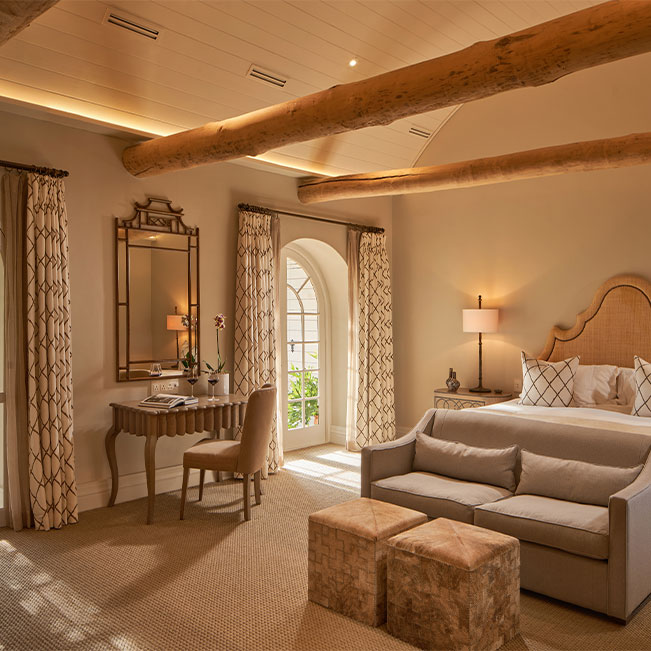
Discover Leeu Heritage
In 2012, Leeu Collection Founder Analjit Singh embarked on an extraordinary journey that would forever transform the picturesque region near Franschhoek.
With unwavering determination and a vision of grandeur, he set out to reshape the renowned wine farms dating back to 1800 - Dieu Donné, Klein Dassenberg and Von Ortloff - into a sanctuary of unparalleled luxury.
These historical wine farms (with the addition of the Joyous Garde Wine Estate) have undergone a masterful metamorphosis over the years.
Today, they stand united as a resplendent five-star destination encompassing an expansive 68 hectares of enchanting vineyards and gardens.
At the very heart of this landscape, Leeu Estates has emerged - its architecture paying homage to the rich Cape Dutch heritage that can be seen throughout.
Every intricate detail of the Estates’ restorations has been thoughtfully curated to blend the cherished elements of the past with the vibrant spirit of the present.
Journey back in time with us to learn more about each unique building…
Leeu Estates Manor House
This enchanting property, once the original farmstead of Klein Dassenberg, resides along the historic route tracing the picturesque banks of the Berg River to Franschhoek.
With roots dating back to the late 1800s, its core features a charming, thick-walled dairy. While the interior exudes contemporary elegance, the enduring allure of the older gable ends from 1990 and 1993 add a timeless charm.
Notably, the esteemed Marie Greeff, a previous owner, shares a captivating familial bond as the cousin of Princess Michael of Kent. The princess found solace and tranquility within the remarkable walls of this house during her South African holidays, alongside her cherished cousin.
Terroir Cottage
The charming cottage, adorned with a gable dating back to 1949, is believed to have been constructed in the early 1800s. Throughout its history, the building has served as a versatile space, fulfilling roles as both storage and a humble abode for diligent farm workers. Its timeless presence stands as a testament to the enduring legacy of Dassenberg Farm.
Max House
Max House boasts a captivating history dating back to 1831, when Johannes Petrus Kriel acquired ownership of the house, two outbuildings, and the vast surrounding farmland. The 1831 survey proudly confirms the existence of the farmhouse and outbuildings, likely built between 1805 and 1831.
Originally designed in the timeless T shape, the farmstead reflects a simplistic, neo-classical style prevalent in the late 1700s. Over time, it has undergone various modifications, expanding into the iconic H shape, with ongoing alterations and expansions. While some original internal wooden doors and remnants of the gable endure, little else remains of the original structure.
Max House stands as a testament to the passage of time and the evolution of architectural aesthetics, its allure residing in the hidden layers of history within its walls.
Cellar Cottage
The 1831 survey of Dassenberg Farm offers an intriguing glimpse into its rich history, revealing the presence of a main farmstead and a remarkable outbuilding. Today, this very outbuilding is affectionately known as Cellar Cottage.
Its storied past is beautifully reflected in a gable dating back to 1800. The cottage still boasts a wooden door adorned with a band-and-pintle hinge from the late 1700s, adding an exquisite touch of authenticity.
Pomegranate Cottage
Embracing the timeless charm of traditional Cape Dutch style, this modernised cottage came to life around 2010.
Adding to its allure is a wall that harks back to an original cottage built circa 1831. This intriguing piece of history sparks conjecture that the cottage may have served as slave quarters, albeit for a brief period. Following the emancipation of slaves in 1834, it likely became a residence for devoted labourers or newly freed individuals, preserving its role as a place of shelter and belonging. This captivating narrative enhances the rich tapestry of the cottage's past.
Protea House
Protea House, once the main dwelling of the former Dieu Donne farm now owned by Leeu Estates, carries the charm of its presumed 1930s construction. While it showcases elements of Modernist design and Cape Revival influences, much of its original detailing from that era has been lost over time.
A fascinating chapter unfolds as we learn that Lee Radziwill, the younger sister of Jaqueline Bouvier Kennedy, resided in the house during the late 1940s and early 1950s. Her visits before her marriage to John F. Kennedy add a touch of glamorous allure to its legacy.
Protea House captivates with tales of grandeur, connections to notable figures, and an eternal view that celebrates the profound bond between past and present.
Ready to step back in time and experience luxury winelands heritage for yourself?
Contact our Guest Liaison team to get started.





